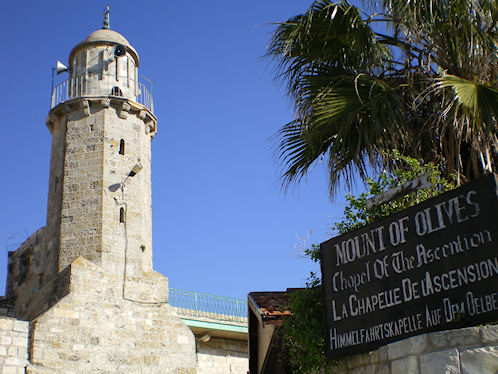Jerusalem.
Israel.
Travel & Tour
Pictures, Photos, Information & Reviews.
Eve & George, DeLange
May 2014.
Google Map To Mount Of Olives, Jerusalem, Israel.
View Larger Map
We Are Proud Of Our SafeSurf Rating!
Click On Any Of The Following Links By Amazon.Com
For Books Or Videos About Touring In Israel. No Obligation!
We wish to thank Wikipedia, the free encyclopedia for some of the information on our web pages. We share images and information with Wikipedia. We also donate to Wikipedia, & would suggest that others do the same.
The Mount of Olives (Mount Olivet), or in Hebrew (Har HaZeitim), is a mountain ridge east of, and adjacent to Jerusalem's Old City. It is named for the olive groves that once covered its slopes. The southern part of the Mount was the necropolis of the ancient Judean kingdom. The Mount has been used as a Jewish cemetery for over 3,000 years, and holds approximately 150,000 graves, making it central in the tradition of Jewish cemeteries. Several key events in the life of Jesus as related in the Gospels took place on the Mount of Olives, and in the Book of Acts it is described as the place from which Jesus ascended to heaven. Because of its association with both Jesus and Mary, the Mount has been a site of Christian worship since ancient times and is today a major site of Christian pilgrimage for the Orthodox, Catholic and Protestant Christians. The Mount of Olives is one of three peaks of a mountain ridge which runs for 3.5 kilometres (2.2 miles) just east of Old Jerusalem, across the Kidron Valley, in this area called the Valley of Josaphat. The peak to the north of the Mount of Olives ,is Mount Scopus, at 826 metres (2,710 feet), while the peak to the south is the Mount of Corruption, at 747 m (2,451 ft). The highest point on the Mount of Olives is at-Tur, at 818 m (2,684 ft)). The ridge acts as a watershed, and its eastern side is the beginning of the Judean Desert. The ridge is formed of oceanic sedimentary rock from the Late Cretaceous, and contains a soft chalk and a hard flint. While the chalk is easily quarried, it is not a suitable strength for construction, which is why the Mount was never built up, and instead features many man-made burial caves. From Biblical times until the present, Jews have chosen to have been buried on the Mount of Olives. Because: "Since Antiquity," based upon the Biblical Verse In Zechariah 14:4 says that when The Messiah comes, the "Resurrection Of The Dead" will begin there. The necropolis on the southern ridge, the location of the modern village of Silwan, was the burial place of Jerusalem's most important citizens during the period of the Biblical kings. There are an estimated 150,000 graves on the Mount, including tombs traditionally associated with Zechariah and Absalom. On the upper slope, the traditional Tomb of the Prophets Haggai, Zechariah and Malachi is situated. Notable rabbis buried on the mount include Chaim ibn Attar and others from the 15th-century to present Roman soldiers from the 10th Legion camped on the Mount during the Siege of Jerusalem in the year 70 CE. The Jewish religious ceremony marking the start of a new month was held on the Mount of Olives in the days of the Second Temple. After the destruction of the Temple, Jews celebrated the festival of Sukkot on the Mount of Olives. The Jews made pilgrimages to the Mount of Olives because it was 80 meters (263 feet) higher than the Temple Mount and offered a panoramic view of the Temple site. It also became a traditional place for lamenting the Temple's destruction, especially on Tisha B'Av. In the Old Testament the Mount of Olives is first mentioned in connection with David's flight from Absalom (II Samuel 15:30): "And David went up by the ascent of the Mount of Olives, and wept as he went up." The ascent was probably east of the City of David, near the village of Silwan. The sacred character of the mount is alluded to in the Old Testament in Ezekiel (11:23): "And the glory of the Lord went up from the midst of the city, and stood upon the mountain which is on the east side of the city." The biblical designation in the Old Testament, " Mount of Corruption, or in Hebrew Har HaMashchit" (I Kings 11:7�8), derives from the idol worship on the mount, begun by King Solomon in building altars to the gods of his Moabite and Ammonite wives on the southern peak, "on the mountain which is before (east of) Jerusalem" (Kings I 11:7), just outside the limits of the holy city. This site was infamous for idol worship throughout the First Temple period, until king of Judah, Josiah, finally destroyed "the high places that were before Jerusalem, to the right of Har HaMashchit..."(II Kings 23:13). An apocalyptic prophecy in the Book of Zechariah states that Yahweh will stand on the Mount of Olives and the mountain will split in two, with one half shifting north and one half shifting south (Zechariah 14:4). According to the Masoretic Text, people will flee through this newly formed valley to a place called Azal (Zechariah 14:5). The Septuagint (LXX) has a different reading of Zechariah 14:5 stating that a valley will be blocked up as it was blocked up during the earthquake during King Uzziah's reign. Jewish historian Flavius Josephus mentions in Antiquities of the Jews that the valley in the area of the King's Gardens was blocked up by landslide rubble during Uzziah's earthquake. Israeli geologists Wachs and Levitte identified the remnant of a large landslide on the Mount of Olives directly adjacent to this area. Based on geographic and linguistic evidence, Charles Simon Clermont-Ganneau, a 19th-century linguist and archeologist in Palestine, theorized that the valley directly adjacent to this landslide is Azal. This evidence accords with the LXX reading of Zechariah 14:5 which states that the valley will be blocked up as far as Azal. The valley he identified (which is now known as Wady Yasul in Arabic, and Nahal Etzel in Hebrew) lies south of both Jerusalem and the Mount of Olives. The Mount of Olives is frequently mentioned in the New Testament (Matthew 21:1;26:30, etc.) as the route from Jerusalem to Bethany and the place where Jesus stood when he wept over Jerusalem (an event known as Flevit super illam in Latin language). Jesus is said to have spent time on the mount, teaching and prophesying to his disciples (Matthew 24�25), including the Olivet discourse, returning after each day to rest (Luke 21:37), and also coming there on the night of his betrayal (Matthew 26:39). At the foot of the Mount of Olives lies the Garden of Gethsemane. The New Testament, tells how Jesus and his friends sang together � "When they had sung the hymn, they went out to the Mount of Olives" Gospel of Matthew 26:30. Jesus ascended to heaven from the Mt of Olives as recorded in the book of Acts 1:9�12.
|
The easy way to get to Mount Of Olives, Jerusalem, Israel, is to fly into the Ben Gurion International Airport. The airport is at the junction of the Haifa, Jerusalem, Dan, and Tel Aviv metropolitan areas. The Ben Gurion International Airport, (IATA: TLV, ICAO: LLBG), also referred to by its Hebrew acronym Natbag, is the largest and busiest international airport in Israel. It was named the best airport in the Middle East by the ACI organisation.[ The airport is located near the city of Lod, 15 km (9 mi) southeast of Tel Aviv. It is operated by the Israel Airports Authority, a government-owned corporation that manages all public airports and border crossings in the State of Israel. The Ben Gurion International Airport is considered one of the world's most secure airports, with a security force that includes both police officers and IDF soldiers. There are several hotels in or near Jerusalem. There are several Guided Tour Agencies offering standard city, and historical tours of Jerusalem, Israel and the surrounding areas. After arranging your flight we would suggest getting your hotel and then letting them arrange tours of the area for you. If you call the hotels Concierge Services ahead of your arrival, all of this can be pre-arranged for you. I do this all the time. It is safe and it works!!! I have never experienced a problem doing it this way! I have links to Priceline.Com on our page so that you can arrange your flight and hotel in the Jerusalem, Israel area.
|
| Church Of All Nations. Basilica Of The Agony. Mount Of Olives, Jerusalem, Israel. | Cemetery. Mount Of Olives, Jerusalem, Israel. |
|---|---|
| Marys Tomb. Mount Of Olives, Jerusalem, Israel. | Zkharia Hezir Tombs. Mount Of Olives, Jerusalem, Israel. |
 | |
| Chapel Of The Ascension. Mount Of Olives, Jerusalem, Israel. | Christ's Footprint. Chapel Of The Ascension. Mount Of Olives, Jerusalem, Israel. |
| Church Of Mary Magdalene. Mount Of Olives, Jerusalem, Israel. | LDS Orson Hyde Garden. Mount Of Olives, Jerusalem, Israel. |
We Are Proud Of Our SafeSurf Rating!
Click On Any Of The Following Links By Amazon.Com
For Books Or Videos About Touring In Israel. No Obligation!
| Back To Israel Travel Or Tours With Audrey Main Page
|
| Back To Israel Travel Or Tours With Eve & George Main Page
|
| Back To Ancient Possible Book Of Mormon Lands Main Page
|
| Back To DeLange Home Page |
